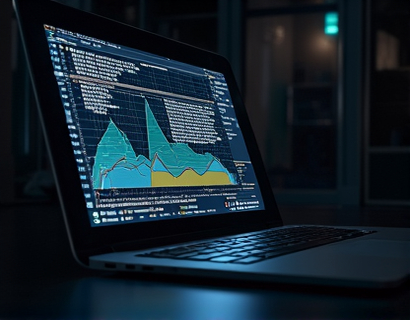Elevate Token Management: Harnessing Smart-Contract Innovation for UCASH and U Assets
The landscape of digital asset management is undergoing a transformative shift, driven by the integration of smart-contract technology. This evolution offers unprecedented opportunities for enhancing security, efficiency, and performance in managing tokens tied to leading cryptocurrencies and digital assets. At the forefront of this revolution is the development of advanced smart-contract solutions specifically designed for the secure and efficient creation and management of tokens pegged to UCASH and other U assets. This article delves into the intricacies of these innovations, exploring how they are reshaping the future of digital asset management.
Understanding Tokenization and Smart Contracts
Tokenization refers to the process of converting rights to an asset into a digital token on a blockchain. These tokens can represent a wide range of assets, from real estate and commodities to cryptocurrencies and utility tokens. Smart contracts, self-executing contracts with the terms of the agreement directly written into code, play a pivotal role in this process. They automate and enforce the rules governing token creation, distribution, and management, ensuring transparency, security, and efficiency.
Smart contracts on blockchain platforms like Ethereum provide a decentralized and trustless environment for executing transactions. This means that once the conditions set within the smart contract are met, the transaction is automatically executed without the need for intermediaries. This not only reduces costs and speeds up processes but also minimizes the risk of fraud and human error.
Advantages of Smart-Contract-Based Token Management
The integration of smart contracts in token management offers several key advantages. First and foremost, it enhances security. Smart contracts are immutable once deployed, meaning that once the code is written, it cannot be altered. This immutability ensures that the rules governing token behavior are consistent and unchangeable, providing a high level of security against tampering and fraud.
Efficiency is another significant benefit. Traditional token management often involves multiple intermediaries, each adding a layer of complexity and delay. Smart contracts automate these processes, allowing for near-instantaneous execution of transactions. This not only speeds up operations but also reduces the administrative burden and associated costs.
Moreover, smart contracts provide transparency. All transactions and contract states are recorded on the blockchain, which is visible to all participants. This level of transparency builds trust among users and stakeholders, as everyone can verify the integrity of the token management process.
Creating Tokens Pegged to UCASH and U Assets
UCASH, a leading cryptocurrency, and other U assets offer a robust foundation for tokenization due to their stability and utility. Tokens pegged to these assets can serve various purposes, from facilitating decentralized finance (DeFi) applications to providing a stable store of value. The process of creating such tokens involves several steps, each facilitated by smart-contract technology.
First, a smart contract is deployed on the blockchain to define the token's parameters, including its name, symbol, total supply, and the asset it is pegged to. This contract serves as the rulebook for the token, outlining how it can be created, transferred, and redeemed.
The next step involves establishing a reserve of the underlying asset. This reserve ensures that each token represents a proportional amount of the asset it is pegged to. Smart contracts can automate the process of adding and removing assets from the reserve, maintaining the token's peg and ensuring its value stability.
Once the token and reserve are set up, users can interact with the smart contract to perform various operations. For instance, users can mint new tokens by depositing the underlying asset into the reserve. Conversely, they can redeem tokens by withdrawing the asset from the reserve. These transactions are executed automatically by the smart contract, ensuring accuracy and speed.
Enhancing Security with Smart Contracts
Security is paramount in digital asset management, and smart contracts offer robust mechanisms to safeguard tokens and underlying assets. One of the primary security features is the use of cryptographic hashes. Each transaction and contract state is associated with a unique hash, which ensures that any alteration to the data would be immediately detectable.
Another critical aspect is the auditability of smart contracts. Before deployment, contracts can undergo rigorous testing and auditing by security experts to identify and mitigate potential vulnerabilities. This proactive approach helps in ensuring that the smart contract is free from bugs and exploits that could compromise the system.
Additionally, the use of multi-signature wallets and access controls within smart contracts adds an extra layer of security. These features require multiple approvals for critical operations, such as modifying the reserve or deploying new contracts, thereby reducing the risk of unauthorized actions.
Optimizing Performance through Smart Contracts
Performance is a crucial factor in the success of any digital asset management system. Smart contracts excel in this area by streamlining processes and reducing latency. Traditional systems often rely on centralized servers and intermediaries, which can introduce delays and bottlenecks. In contrast, smart contracts operate on a decentralized network, allowing for faster and more reliable transaction processing.
Moreover, smart contracts can be optimized for scalability. By leveraging layer 2 solutions and other blockchain scaling techniques, the system can handle a higher volume of transactions without compromising performance. This scalability is essential for managing large-scale tokenized assets and ensuring a smooth user experience.
Another performance enhancement comes from the automation of complex workflows. Smart contracts can handle multiple steps in a token's lifecycle, from creation to redemption, without the need for manual intervention. This automation not only speeds up processes but also reduces the potential for human error, leading to more reliable and efficient operations.
Use Cases and Applications
The applications of smart-contract-based token management are vast and varied. In the realm of decentralized finance (DeFi), tokens pegged to UCASH and other U assets can be used to create stable loans, decentralized exchanges, and yield farming opportunities. These applications leverage the stability and predictability of the pegged tokens to provide users with robust financial tools.
In the real estate sector, tokens can represent fractional ownership of properties, making investment more accessible to a broader audience. Smart contracts can automate the transfer of ownership and manage rental agreements, ensuring transparency and efficiency in property management.
Furthermore, in the supply chain industry, tokens can be used to track the movement and authenticity of goods. This not only enhances transparency but also helps in verifying the origin and quality of products, which is particularly important in industries like pharmaceuticals and luxury goods.
Challenges and Considerations
While the benefits of smart-contract-based token management are significant, there are also challenges and considerations that need to be addressed. One of the primary concerns is the regulatory landscape. The use of cryptocurrencies and tokens is subject to varying regulations across different jurisdictions, and compliance is essential to avoid legal issues.
Another challenge is the technical complexity involved in deploying and maintaining smart contracts. Developers need to have a deep understanding of blockchain technology and smart-contract programming to ensure that the contracts are secure and function as intended. Continuous monitoring and maintenance are also required to address any issues that may arise.
Interoperability is another area that requires attention. As the blockchain ecosystem grows, the ability for different platforms and contracts to communicate and work together seamlessly becomes increasingly important. Standards and protocols that facilitate interoperability will play a crucial role in the widespread adoption of smart-contract-based token management.
Conclusion
The integration of smart-contract technology in token management represents a significant leap forward in the digital asset space. By leveraging the security, efficiency, and transparency of smart contracts, users can experience a more robust and reliable system for managing tokens pegged to UCASH and other U assets. As the technology continues to evolve, we can expect even more innovative applications and use cases, further enhancing the potential of digital asset management.
For those interested in exploring this cutting-edge technology, platforms and tools are emerging to provide user-friendly interfaces for creating and managing smart-contract-based tokens. These platforms aim to democratize access to tokenization, making it accessible to a wider audience, including cryptocurrency enthusiasts and blockchain developers.










































